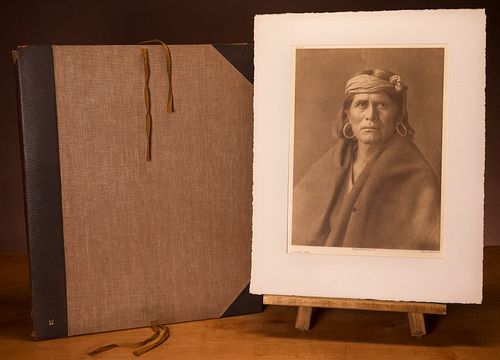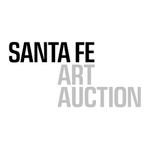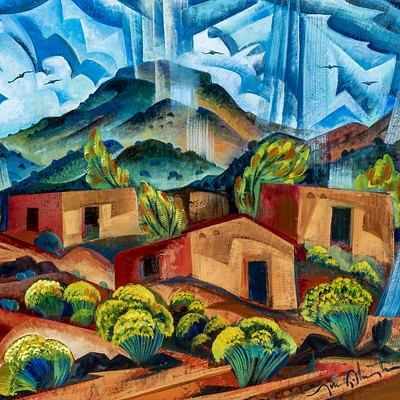Edward S. Curtis, The North American Indian Portfolio XII, 1922
About Seller
932 Railfan Road
Santa Fe, NM 87505
United States
Boasting the third-largest art market in the United States, Santa Fe has long been a destination for new and seasoned collectors. Located in the heart of the city’s historic downtown, and organized in conjunction with the Gerald Peters Gallery, the Santa Fe Art Auction is the Southwest’s premier ann...Read more
Two ways to bid:
- Leave a max absentee bid and the platform will bid on your behalf up to your maximum bid during the live auction.
- Bid live during the auction and your bids will be submitted real-time to the auctioneer.
Bid Increments
| Price | Bid Increment |
|---|---|
| $0 | $100 |
| $2,000 | $250 |
| $5,000 | $500 |
| $10,000 | $1,000 |
| $20,000 | $2,500 |
| $50,000 | $5,000 |
| $100,000 | $10,000 |
About Auction
Nov 5, 2022
2022 SIGNATURE ANNUAL LIVE Session II Santa Fe Art Auction info@santafeartauction.com
- Lot Description
Edward S. Curtis
(1868 - 1952)
The North American Indian Portfolio XII, 1922
36 photogravures on Japanese Gampi tissue with original Van Gelder overmats
signed in the plate below image: E. S. Curtis
Featuring the Hopi tribe of the Southwest.
LIMITED EDITION: This Portfolio is from set #96, printed on handmade Japanese gampi tissue paper, quarto, original ¾ brown crushed levant by H. Blackwell of Boston, over beige linen-covered boards, original gilt lettered, with photogravure plates by Suffolk Engraving Company of Boston after photographs by Edward S. Curtis, edited by Frederick Webb Hodge, Chief of the Bureau of American Ethnology, field research conducted under the patronage of J. Pierpont Morgan.
PORTFOLIO: 36 large format photogravures, including a List of Plates reference that is hand letterpress printed on hand-made paper. Loose bound in a hand-made, 3-flap portfolio.
In the summer of 1900, after his brief expedition with George Bird Grinnell to the Great Plains, Curtis made his first independent, self-financed trip into the field. For this important trip, he chose to photograph the Hopi, Navajo, and Apache of the Southwest. He was intrigued by what he had read and heard about their rich, traditional culture and their spectacular ceremonies. Curtis’s initial intrigue was confirmed during this visit, and from 1900 to 1925 Curtis would study and photograph the various tribes of the Southwest more frequently than those of any other area. He ultimately devoted more volumes of The North American Indian to the Southwest than to any other region. Portfolio XII focuses exclusively on the Hopi, showing aspects of their architecture, mythology, arts and dress. Many of Curtis’ most compelling photographs can be found in this portfolio. There are the striking portraits of “A Hopi Man” and “A Walpi Man”. “The Potter” depicting the skilled artisan named Nampeyo. And four incredible portraits of Hopi Snake Priests, in addition to images of their Buffalo and Snake Dance ceremonies. Said Curtis, “I couldn’t make pictures of their religious ceremonies unless I entered into their inner life and understood it from their standpoint.” Curtis’s immersion in the cultures of the Southwest Indians, which were so inextricably intertwined with the land itself, is clearly evident in the photographs he made in the region.
folio: 23 x 19 in. (58.42 x 48.26 cm.), prints: 18 x 22 in. (45.72 x 55.88 cm.)
Edward S. Curtis Studio
William Henry Moore
The Moore Memorial Library
The Christopher G. Cardozo Collection, 2001
Exhibited:
Watching the Dancers, Plate 405
Sacred Legacy: Edward S. Curtis and the North American Indian (176 print exhibit), 2000
Edward S. Curtis: 100 Masterworks, 2016 - Shipping Info
-
The Santa Fe Art Auction does not offer in-house shipping, with the exception of jewelry, but a selection of local third-party shippers can be found on our website and in the linked release form below. Buyers are required to provide written authorization by submitting a signed shipping release and waiver of liability form, included with our invoice, in order to release property to the third party shipper of Buyer’s choice. Purchases cannot be shipped or released until payment is received in full. https://www.santafeartauction.com/auctions/shipping-form/
-
- Buyer's Premium



 EUR
EUR CAD
CAD AUD
AUD GBP
GBP MXN
MXN HKD
HKD CNY
CNY MYR
MYR SEK
SEK SGD
SGD CHF
CHF THB
THB






















